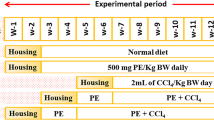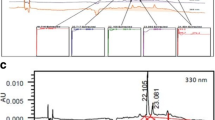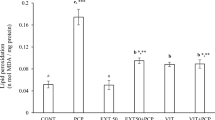Abstract
The short-term toxicity of PAI-N002, a mixture of Schizandra chinensis, Astragalus membranaceus, Artemisia capillaris, and Coriolus versicolor extracts (1 : 1 : 1 : 1), was evaluated in rats. This study also investigated the protective effect of PAI-N002 on liver injury induced by the co-administration of ethanol and carbon tetrachloride (EC) in rats. PAI-N002 was virtually non-toxic to rats after a single oral administration, with LD50 values > 5,000 mg/kg. The subacute toxicity study showed that 2-week repeated oral dose of PAI-N002 did not cause any adverse effects on clinical signs, body weight, food consumption, ophthalmoscopy, hematology, serum biochemistry, gross findings, and organ weights in rats given up to 1,000 mg/kg/day. When rats with EC-induced hepatotoxicity were treated with PAI-N002 at 250 mg/kg/day for 28 days, PAI-N002 treatment significantly improved EC-induced hepatic injury, as evidenced by the decline of serum AST and ALT activities and decreased histopathological alterations. PAI-N002 also had an antioxidant benefit by decreasing the lipid peroxidative product malondialdehyde and increasing the levels of the antioxidant glutathione and the activities of the antioxidant enzymes catalase, superoxide dismutase, and glutathione-S-transferase. These results indicate that the short-term treatment of rats with PAI-N002 has no harmful effects and that PAI-N002 has hepatoprotective and antioxidant properties in EC-induced chronic liver injury in rats.
Similar content being viewed by others
References
Barnes, P. M., Powell-Griner, E., McFann, K. & Nahin, R. L. Complementary and alternative medicine use among adults: United States, 2002. Adv Data 343:1–19 (2004).
Mahady, G. B. Global harmonization of herbal health claims. J Nutr 131:1120S–1123S (2001).
Seeff, L. B., Lindsay, K. L., Bacon, B. R., Kresina, T. F. & Hoofnaqle, J. H. Complementary and alternative medicine in chronic liver disease. Hepatology 34: 595–603 (2001).
Lee, K. J. & Jeong, H. G. Protective effect of Platycodi radix on carbon tetrachloride-induced hepatotoxicity. Food Chem Toxicol 40:517–525 (2002).
Fogden, E. & Neuberger, J. Alternative medicines and the liver. Liver Int 23:213–220 (2003).
Hanje, A. J., Fortune, B., Song, M., Hill, D. & McClain, C. The use of selected nutrition supplements and complementary and alternative medicine in liver disease. Nutr Clin Pract 21:255–272 (2006).
Muriel, P. & Rivera-Espinoza, Y. Beneficial drugs for liver diseases. J Appl Toxicol 28:93–103 (2008).
Sinclair, S. Chinese herbs: a clinical review of Astragalus, Ligusticum and Schizandrae. Altern Med Rev 3:38–344 (1998).
Zhu, M., Lin, K., Yeung, R. & Li, R. Evaluation of the protective effects of Schisandra chinensis on phase I drug metabolism using a CCl4 intoxication model. J Ethnopharmacol 67:61–68 (1999).
Kim, I. S. & Choi, S. Y. Physicochemical properties and antioxidative activities of Omija (Schizandra chinensis Bailon). Korean J Food Nutr 21:35–42 (2008).
Yan, F. et al. Synergistic hepatoprotective effect of Schisandrae lignans with Astragalus polysaccharides on chronic liver injury in rats. Phytomedicine 16:805–813 (2009).
Liu, X. et al. Studies on biologically active principles of Huangqi, root of Astragalus membranaceus, isolation and detection of constituents scavenging superoxide anion. J Clin Pharm Sci 2:80–84 (1993).
Toda, S. & Shirataki, Y. Inhibitory effects of Astragali Radix, a crude drug in oriental medicines, on lipid peroxidation and protein oxidative modification by copper. J Ethnopharmacol 68:331–333 (1999).
Gui, S. Y. et al. Effects and mechanisms of crude astragalosides fraction on liver fibrosis in rats. J Ethnopharmacol 103:154–159 (2006).
Kiso, Y., Sasaki, K., Oshima, Y. & Hikino, H. Liverprotective drugs V. Validity of the oriental medicines. 42. Structure of arcapillin, an antihepatoxic principle of Artemisia capillaries herba. Heterocycles 19:1615–1517 (1982).
Lee, S. G. The therapeutic effect of Artemisia Capillaris extract on hepatic damage induced by carbon tetrachloride in rats. J Vet Clin 22:206–213 (2005).
Wei, W. S. et al. Effects of Coriolus versicolor polysaccharides on superoxide dismutase activities in mice. Zhongguo Yao Li Xue Bao 17:174–178 (1996).
Fisher, M. & Yang, L. X. Anticancer effects and mechanisms of polysaccharide-K (PSK): implications of cancer immunotherapy. Anticancer Res 22:1737–1754.
Bent, S. Herbal medicine in the United States: review of efficacy, safety, and regulation. J Gen Intern Med 23:854–859 (2008).
Pradhan, S. C. & Girish, C. Hepatoprotective herbal drug, silymarin from experimental pharmacology to clinical medicine. Indian J Med Res 124:491–504 (2006).
De Smet, P. A. Herbal remedies. N Engl J Med 347: 2046–2056 (2002).
Deng, J. F. Clinical and laboratory investigations in herbal poisonings. Toxicology 181:571–576 (2002).
Jin, T. Y. Toxicological research on Yun Zhi polysac-charopeptide (PSP): In International Symposium on Traditional Chinese Medicine and Cancer: Development and Clinical Validation-Advances Research in PSP (Yan, Q. Y. ed), Hong Kong Association for Health Care Ltd, 76–79 (1999).
Kordali, S., Aslan, I., Calmasur, O. & Cakir, A. Toxicity of essential oils isolated from three Artemisia species and some of their major components to granary weevil, Sitophilus granaries (L.) (Coleoptera: Curculionidae). Ind Crop Prod 23:162–170 (2006).
Yu, S. Y. et al. Subchronic toxicity studies of Radix Astragali extract in rats and dogs. J Ethnopharmacol 110:352–355 (2007).
Molander, D. W., Wroblewsk, F. & La Due, J. S. Transaminase compared with cholinesterase and alkaline phosphatase an index of hepatocellular integrity. Clin Res Proc 3:20–24 (1995).
Zimmerman, H. J. & Seeff, L. B. Enzymes in hepatic disease: In Diagnostic Enzymology (Goodley, E. L. ed.), Lea and Febiger, Philadelphia, 1–38 (1970).
Johansen, J. S., Harris, A. K., Rychly, D. J. & Ergul, A. Oxidative stress and the use of antioxidants in diabetes: linking basic science to clinical practice. Cardiovas Diabetol 4:5 (2005).
Valko, M. et al. Free radicals and antioxidants in normal physiological function and human disease. Int J Biochem Cell Biol 39:44–84 (2007).
Lieber, C. S. Role of oxidative stress and antioxidant therapy in alcoholic and nonalcoholic liver diseases. Adv Pharmacol 38:601–628 (1997).
Weber, L. W. D., Bull, M. & Stampfl, A. Hepatotoxicity and mechanism of action of haloalkanes: carbon tetrachloride as a toxicological model. Crit Rev Toxicol 33:105–136 (2003).
Williams, A. C. & Christopher, W. Relationship between reactive oxygen species production and lipid peroxidation in human sperm suspensions and their association with sperm function. Fertil Steril 83:929–936 (2005).
Wilcox, J. K., Ash, S. L. & Catignani, G. L. Antioxidants and prevention of chronic disease. Crit Rev Food Nutr 44:275–295 (2004).
Yang, Y. S. et al. Protective effects of Pycnogenol® on carbon tetrachloride-induced hepatotoxicity in Sprague-Dawley rats. Food Chem Toxicol 46:380–387 (2008).
Lin, S., Fujii, M. & Hou, D. X. Molecular mechanisms of apoptosis induced by schzandrae-derived lignans in human leukemia HL-60 cells. Food Chem Toxicol 46:590–597 (2008).
Seo, H. C. et al. Extraction and identification of antioxidant components from Artemisia capillaris herba. Plants Foods Hum Nutr 58:1–12 (2003).
Polese, J. M. The Pocket Guide to Mushrooms. Cologne. Germany, 1–382 (1999).
Erman, F., Balkan, J., Cevikbas, U., Kocak-Toker, N. & Uysal, M. Betaine or taurine administration prevents fibrosis and lipid peroxidation induced by rat liver by ethanol plus carbon tetrachloride intoxication. Amino Acids 27:199–205 (2004).
Berton, T. R. et al. The effect of vitamin E acetate on ultraviolet-induced mouse skin carcinogenesis. Mol Carcinog 23:175–184 (1998).
Moron, M. S., Depierre, J. W. & Mannervik, B. Levels of glutathione, glutathione reductase and glutathione-S-transferase activities in rat lung and liver. Biochem Biophys Acta 582:67–78 (1979).
Aebi, H. Catalase in vitro. In: Packer, L. (Ed.), Methods in Enzymology, vol. 105. Academic Press, San Diego, 121–126 (1984).
McCord, J. M. Mutant mice, Cu, Zn superoxide dismutase, and motor neuron degeneration. Science 266: 1586–1587 (1994).
Habig, W. H., Jakoby, W. B., Guthenberg, C., Mannervik, B. & Vander Jagt, D. L. 2-Propylthiouracil does not replace glutathione for the glutathione transferases. J Biol Chem 259:7409–7410 (1984).
Lowry, O. H., Rosebrough, N. J., Farr, A. L. & Randall, R. J. Protein measurement with folin phenol reagent. J Biol Chem 193:265–275 (1951).
Author information
Authors and Affiliations
Corresponding author
Rights and permissions
About this article
Cite this article
Kim, SH., Lim, JH., Shin, IS. et al. Evaluation of the toxicological properties and hepatoprotective effects of PAI-N002, a mixture of herbal extracts, in rats. Mol. Cell. Toxicol. 6, 239–246 (2010). https://doi.org/10.1007/s13273-010-0033-2
Received:
Accepted:
Published:
Issue Date:
DOI: https://doi.org/10.1007/s13273-010-0033-2




